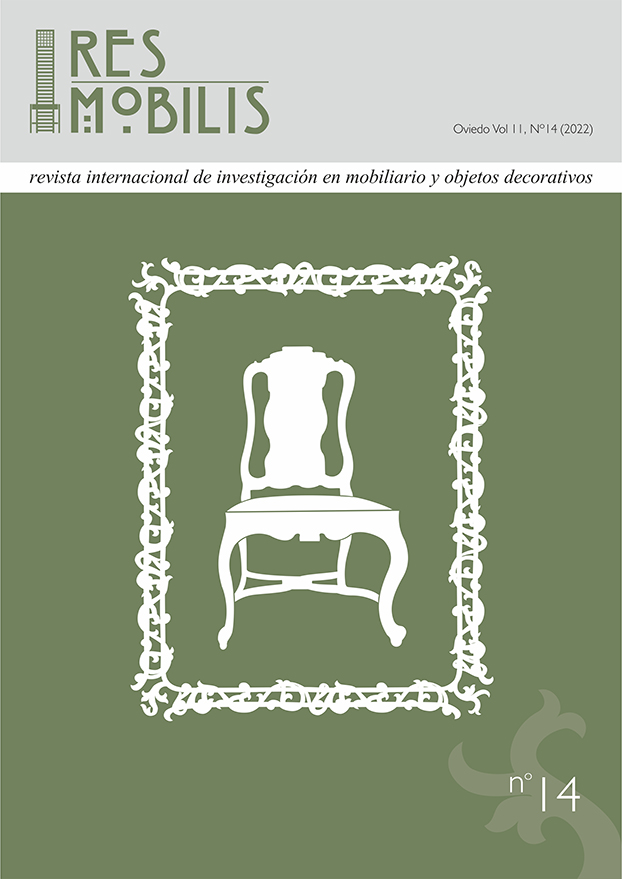Resumo
Los motivos vegetales fueron de gran importancia en las artes del antiguo Egipto. Fueron interesante por sus unidades decorativas y sus formas estéticas. La flor de loto fue una de las más conocidas plantas de la antigua civilización egipcia gracias a su asociación con la religiosidad y la vida cotidiana de los antiguos egipcios. Esta flor, de colores blanco, azul y rojo como símbolo de la vida en Egipto, no sólo era un componente este´tico decorativo que se representaba en las paredes de los templos o se empleaba en la fabricación de cosméticos y perfumes, sino que también se empleaba en la decoración de palacio, casas y tumbas. Este estudio investiga cómo los antiguos egipcios imitaron la flor de loto en la arquitectura y la utilizaron en la decoración decorativa de paredes y techos en escenas naturalistas en la decoración de paredes o techos con composición floral, y también en forma de cenefa estampada (friso), tanto en arquitectura civil como religiosa.
Referências
Aldred, Cyril. Akhenaten King of Egypt. London: Thames & Hudson, 1988.
Bénédite, Georges. La Cueillette du Lis et le "Lirinon." in A Propos D'un bas-relief et d'un Frqgment de bas-relief au Musée du Louver. Paris, 1921-1922.
Boulos, Loutfy. Flora of Egypt. volume one. Egypt: Al Hadara Publishing, 1999.
Capart, Jean and Werbrouck, Marcelle. Thèbes: la gloire d'un grand passé. Bruxelles: Vromant, 1925.
Cherpion, Nadine, and Jean-Pierre. Corteggiani, La tombe d'Inherkhâouy (TT 359) à Deir el Medina. vol. I: texte. Le Cire: MIFAO 128, 2010.
Darby, William, Ghalioungui Paul and Grivetti, Louis. Food: The Gift of Osiris. vol.2. London: Academic Press, 1977.
Daressy, Georges. “Le Palais D’Aménophis III el le Birket Habou.” Annales du service des antiquités de l'égypte 4 (1903).
Davies, Nina Macpherson. Ancient Egyptian Paintings: Selected, Copied, and Described by Nina M. Davies; with the Editorial Assistance of Alan H. Gardiner. vol. II: plates LIII-CIV. Chicago: University of Chicago Press, 1936.
Henry, Thomas Garnet. Egyptian Painting and Drawing in the British Museum. Harvard University Press, 1986.
Davies, Nina Macpherson. Ancient Egyptian Paintings: Selected, Copied, and Described by Nina M. Davies; with the Editorial Assistance of Alan H. Gardiner. vol. I: plates I-LII. Chicago: University of Chicago Press, 1936.
Davies, Norman Garis. Seven Private Tombs at Kurnah. London: Egypt Exploration Society, 1948.
Davies, Norman Garis. The Tomb of Ķen-amūn at Thebes. vol. II. New York: The Metropolitan Museum of Art, 1930.
Erman, Adolf and Grapow, Herman. Wörterbuch der Aegyptischen Sprache. Band, IV. Berlin: JC Hinrichs, 1971.
Faulkner, Raymond. A Concise Dictionary of Middle Egyptian. Oxford: Oxford University Press, 1991.
Friedman, Florence. Gifts of the Nile: Ancient Egyptian faïence. London: Thames and Hudson, 1998.
Gardiner, Alan. Egyptian Grammar: being in Introduction to the Study of Hieroglyphs. Oxford: Griffith institute, Ashmolean Museum, 1957.
Germer, Renate. "Flowers", in The Oxford Encyclopedia of ancient Egypt, edited by Redford, Donald. vol .1. translated from German by Julia Harvey. Oxford: Oxford University Press, 2001.
Germer, Renate. Flora des pharaonischen Ägypten. Mainz am Rhein: P. von Zabern, 1985.
Hannig, Rayner. Großes Handwörterbuch: Ägyptisch-Deutsch. Lexica 1. Mainz: Verlag Philipp von Zabern, 2005.
Hepper, Nigel. Pharaoh's Flowers. London: printed in the United Kingdom, 1990.
Kampp-Seyfried (ed.). In the Light of Amarna: 100 Years of the Nefertiti Discovery. Berlin: Ägyptisches Museum und Papyrussammlung, Staatliche Museen zu Berlin, 2012.
Kantor, Helene. Plant Ornament in the Ancient Near East. Doctoral Thesis, University of Chicago, 1945. Revised by the Oriental Institute, 1999.
Lacovara, Peter and Winkels, Alexandra. "Malqata – The Painted Palace." in Tracing Technoscapes: The Production of Bronze Age Wall Paintings in the Eastern Mediterranean. edited by Johannes Becker, Johannes Jungfleisch and Constance von Rüden. Leiden: Sidestone Press, 2018.
Lesko, Leonard and Barbara, Susanne. A Dictionary of Late Egyptian. vol. 3. California: Scribe Publication, 1987.
Negmeldin, Mohsen. "Types of the Ceilings and Its Decorations at ancient Egyptian Architecture." Archi-Cultural Interactions through the Silk Road: 4th International Conference. Japan: Mukogawa Women’s Univ., Nishinomiya, July 16-18, 2016.
Noblecourt, Christiane Desroches. Lorsque La Nature Parlait aux Égyptiens. Éditions Pbilippe Rey. 2003.
Ossian, Clair. "The most Beautiful of Flowers: Water Lilies and Lotuses in ancient Egypt." KMT 10 (1) (1999).
Pommerening, Tanja, Marinova, Elena, and Hendrickx, Stan. "The Early Dynastic Origin of the Water-Lily motif." Chronique d’Égypte LXXXV (2010).
Porter, Bertha and Moss, Rosalind. Topographical Bibliography of Ancient Egyptian Hieroglyphic Texts, Reliefs and Paintings. vol. I: The Theban Necropolis. part 1: Private Tombs. Oxford, 1960.
Prisse d’Avennes. Atals of Egyptian Art. Cairo: The American University in Cairo Press, 2000.
Sewell, Barbara. Egypt under the Pharaohs. New York: Putnam, 1968.
Shaw, Ian and Nicholson, Paul. The British Museum Dictionary of ancient Egypt. Egypt: The American University in Cairo Press, 2002.
Tomashevska, Marija. Sacred Floral Garlands and Collars from the New Kingdom Period and Early Third Intermediate Period in Ancient Egypt. 1550 BC–943 BC. Master Thesis, University of Leiden, 2019.
Weatherhead, Fran. "Painted Pavements in the Great Palace at Amarna." The Journal of Egyptian Archaeology 78 (1992).
Weatherhead, Fran. "Wall-Paintings from the King’s House at Amarna". The Journal of Egyptian Archaeology 81 (1995).
Wilkinson, Alex. The Garden in Ancient Egypt. London: Rubicon Press, 1998.
Wilkinson, Charles Kyrle. Egyptian Wall Paintings: The Metropolitan Museum of Art's Collection of Facsimiles. New York: Metropolitan Museum of Art, 1983.
Arabic References:
عبد الحميد عزب. الأحراچ في مصر الفرعونية منذ عصر ما قبل الأسرات وحتى نهاية الدولة القديمة. رسالة ماجستير غير منشوره، كلية الآداب، جامعة طنطا، 1993.
Azab, Abd el-Hamid. Marshes in Pharaonic Egypt, from the Pre-dynastic Period until The End of The Old Kingdom. Master thesis, Tanta University, 1993.

